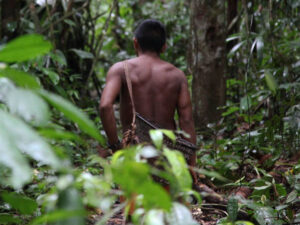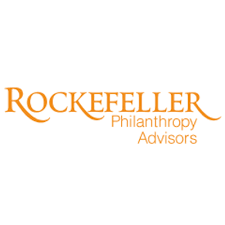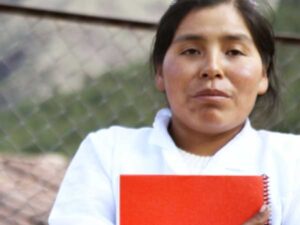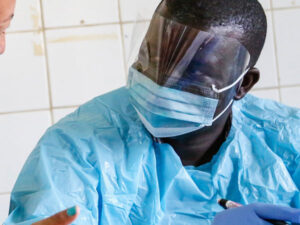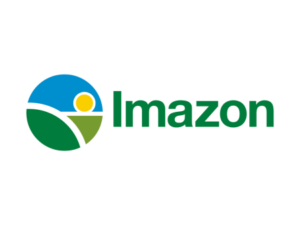The Video Consortium works to democratize the media landscape by connecting and supporting nonfiction filmmakers and visual journalists to tell bold stories that catalyze positive social change.
Sky Dylan-Robbins of The Video Consortium spoke with Ambika Samarthya-Howard on January 26, 2024. Click here to read the full conversation with insights highlighted.
Ambika Samarthya-Howard: Can you please start off by introducing yourself and talking a little bit about what problem you’re trying to address with your organization, and what your approach is in addressing it?
Sky Dylan-Robbins: Glad to be here, Ambika. My name is Sky, and I’m the founder and Executive Director of the Video Consortium (a.k.a. “VC”). I’ll start with the problem we’re addressing:
It’s indisputable that we live in a video-centric society, right? Video is all around us. It’s an essential part of how people stay informed about the world. Before VC, there really wasn’t a space that brought together and supported all of the people who are bringing video into the future and telling today’s big, important stories in video form.
VC is, in a sense, the missing link that holds together and supports today’s nonfiction video storytellers: all of the video-leaning people who don’t necessarily have the backing of major media institutions — or do, and still need the community. And with the trajectory of the gig economy and creatives increasingly being on their own, without any kind of cohesive support system that they know they can lean on, VC’s mission is to fill this gap and be the constant in a media ecosystem that’s always changing.
So we’re concurrently working to create more cohesion within the media and amplify the effective use of video and also provide authentically-rooted support for storytellers. One program that really well exemplifies that is called The Solutions Storytelling Project, which is supported by Skoll. Video is this incredible medium that uniquely allows people to immediately understand what’s happening, right? And socially-driven nonprofits and organizations around the world who are doing such amazing stuff are not typically using video as well as they could to get their message out there. What we’re doing through this program is matching proximate filmmakers — so, filmmakers who should be telling the stories of their own communities and understand the culture and how to communicate solutions-focused messaging in an authentic way — with solutions-driven organizations in their same region. (It’s worth mentioning that a prerequisite for orgs applying for this program are or were supported by Skoll.) Together, the filmmaker and org make a powerful solutions-driven short documentary that the organization can use to amplify their work. It’s a year-long initiative, and throughout it, the filmmakers are uplifted with lots of amazing trainings and master classes and tools about how to elevate their careers. The organizations receive some media and impact trainings too. At the end of the program, the product is this amazing story that’s not a promo video — you know, the unusual founder just talking into a screen — and instead communicates their message in a way that draws people in.
And we’ve had a lot of success with this. Last year, we ran SSP across Africa, with 19 pairs of filmmakers and organizations. So 19 films were brought to life. That’s a lot of solutions-driven content. And they were all really magnificent. Yesterday, actually, one of them was published in Scientific American, and one’s going to be published in Al Jazeera, or AJ+. So, we’re not just making shorts here. The idea is to tell compelling stories about social change and get them seen on a wide scale, so the general public can learn more about these incredible organizations that are kind of flying under the radar for a lot of the world.
This year, we’re doing SSP LatAm, which is bringing 16 pairs of filmmakers and organizations together from across Latin America. Next year, in 2025, we’re doing it across Asia. The impact is really incredible and exciting thus far.
Ambika Samarthya-Howard: Can you give us a specific example of one of the films, maybe the one from Al Jazeera or the one from Scientific American? If you could just walk us through one or two examples to illustrate what you just said.
Sky Dylan-Robbins: Sure. So for example, there’s this great filmmaker in last year’s program, Frank Adegbie, and he was matched with this amazing organization called BudgIT, which helps regions without clean water get systems in place so the communities can thrive. And they’ve had a lot of [media] coverage, but not as much as in a real world “bring it to life” situation so that people can see, you know, “this is what it looks like in action.” So Frank embedded with them and he, as a Nigerian filmmaker, went to this small Nigerian community where BudgIT was coming in and he documented them installing the whole pump system. Frank followed the women who have to go down to the river — these older women who have to go all the way down these steep cliffs, carrying large water jugs, just to get clean water to drink. There was so much sickness in the community. And BudgIT installed a major pump system, and Frank was there when they turned the pump on for the first time.
It was just this incredible experience to see the transformation of solutions in action — and he documented all of it in such a beautiful way. He made a really moving short film and it was published in Scientific American, which is one of the most storied magazines in the US when it comes to science journalism. As an aside, what’s cool about VC is that we’re able to create these trainings and programs, and we also have all of these rich media connections, because so many big, and small, media organizations are already in our network, so it’s really awesome to get to connect all of these dots.
And now BudgIT is also going to use the film to show people how they do their work. So in terms of impact of the Solutions Storytelling Project, the organization gets this really authentic film that brings their work to life, and the filmmaker’s career gets elevated so he is able to keep telling more stories, with even more honed skills. This was Frank’s first international byline as a director as well, and he obviously got paid for it too, so all around, the program goals and outcomes look to contribute to the sustainability of both creative and nonprofit sectors.
Ambika Samarthya-Howard: And then how did you find him? How did you find the filmmaker?
Sky Dylan-Robbins: They both applied to the program through our calls to action, which were also amplified by Skoll, for the organizations, and by our community partners and peer networks, for the filmmakers.
Ambika Samarthya-Howard: Okay, got it. In terms of the work that you do, and we talk about this so much in terms of visual narrative filmmaking, how do you measure success? How do you know you’re making progress?
Sky Dylan-Robbins: Sure. Well, we think of it in a bifurcated way. First, we ask ourselves, how are we making progress for journalism and documentary film, or nonfiction video, as a whole? Like, how are we contributing to help people continue to be able to do their jobs well, ethically, sustainably? And then, in terms of the stories themselves, and this is newer for us, we’re thinking about how society can be impacted by these stories; are they getting the message and taking action from that? How is video being used to make society better, to make people more engaged, et cetera?
On an industry level, we measure jobs gotten, stories produced, pieces that get into film festivals, mentorship. It’s a lot of qualitative stuff, but it’s incredible to see the impact growing and how people are benefiting from the connections and resources VC is facilitating. On a societal level, meanwhile, the question is, for these stories we’re helping to facilitate, how is the public taking action, are beneficial laws being passed, are things changing for the better.
The throughline for VC is truth — which is, hopefully, always told in a compelling way. So anyone who uses video to tell truthful stories can be a member of the community, which is growing so much. And to date, we’ve seen such cool and inspiring things happen across the board, from straight visual journalism to larger docs to short docs to stories on social media, et cetera. It really runs the gamut.
Ambika Samarthya-Howard: When you say different policy stuff or laws put into place, do you mean when organizations use these videos to promote something?
Sky Dylan-Robbins: That could definitely be one way. Like, an organization gets funding for a much-needed program because the film they showed about their work is so compelling and persuasive. On the other hand, a basic example is a film from, say, The New York Times, and many of those on staff are VC members, when they publish a piece. Video is a medium that immediately makes you really feel, you know? So they publish a revelatory short film and people watch it and instantly react. And then people start talking about it and move to change legislation, or something of the sort. That happens with video all the time, and of course, with journalism as a whole. That’s the point after all, right? To shed light on things people need to see so we can improve society. But video is such a democratic tool to reach people, and when used effectively to tell an important story, it’s a bullet. So for us, the big question is can we connect all of these amazing storytellers — and our members are both top Pulitzer and Emmy and you-name-it award winning people as well as emerging super talented folks — so they can all learn from each other and make things that impact the world in a great way, and collaboratively, too, so people aren’t left on their own island, so to speak.
Ambika Samarthya-Howard: I think that will relate to my next question, which is, what are some things that you’ve done that haven’t worked? Either in terms of programming, in terms of organization, in terms of video work in general, or in terms of exactly what you’re saying right now, that bridge between newcomers and people who’ve been experienced?
Sky Dylan-Robbins: That’s a great question. Well, I would say the biggest frustration I have, and I think a lot of us have this frustration within the journalism industry as a whole or the doc industry as a whole, is just that things are so siloed. I worked at NBC before running the Video Consortium, and I would make a short doc, and it would get published on digital, or cut up for broadcast. If all of the departments, which are all trying to accomplish the same thing, were effectively communicating with each other, that short doc could have been repackaged in so many different ways and used for better impact. This did happen a few times, where we would make something and it would be packaged for digital, for YouTube, for broadcast, for a segment that would air on the Today Show, et cetera, but that really wasn’t the norm, because so many departments weren’t and aren’t talking to each other. My colleagues and I would discuss how there was so much more potential for synergy all the time. And when it happened, we had to advocate for it, to fight for it. And I think that’s really analogous to what’s happening across the media ecosystem in general.
And, you know, we’re really striving to combat that. We like to say that VC is a “radical collaborator,” in that collaboration is really important to our team and how we interact with fellow entities within the ecosystem. But I just wish there was more collaboration across the industry in general. We could all be doing more of it. And so that doesn’t quite answer your question of what hasn’t worked [for us], but it’s something that hasn’t worked as much as I want it to work yet.
Ambika Samarthya-Howard: Funding is a challenge for everybody, but outside of funding, what do you think are some of the biggest limitations that are making things like the silos and the limited collaboration happen? What do you think is at play?
Sky Dylan-Robbins: Are you asking that from an organization or an industry-wide angle?
Ambika Samarthya-Howard: That’s a good question. I think specifically from your perspective, from where you sit in your organization. Outside of funding, what have you seen to be the limitations and the biggest challenges that you haven’t yet been able to overcome?
Sky Dylan-Robbins: From where I sit with VC, one thing that I think could really accelerate progress goes back to what we were just saying about collaboration. I think this is a film and documentary issue, and it’s a journalism issue too. (For context, VC straddles both documentary film and journalism worlds.) As an industry, we’re just so awards obsessed. Awards are a really big deal, and people should absolutely be celebrated for their work in a big way, but I think there should be more of an emphasis on how we all put our heads together and make media a sustainable practice for people, and make sure the stories we’re telling are getting out there and really making an impact. Because journalists are struggling, video people [are struggling], everyone is kind of struggling. If we could pool more resources and brain trusts together — and I’m not talking about money, necessarily — to address the fact that a lot of the time, you see these brilliant creatives saying, “Hey guys, I got this award at Sundance,” but they’re still really struggling. And that award, in many, or most, cases won’t change it. They’re still caught in the cycle, and that’s ultimately what we want to contribute to mitigating.
Ambika Samarthya-Howard: Do you see yourself as a systems change orchestrator?
Sky Dylan-Robbins: I’d say so, like an infrastructure builder, you know? Connections really do matter, whether we like it or not. And so our goal, and what we’re starting to do in an effective way, is pull back the curtain on some of those industry secrets, on how things are done, and actually create those essential connections for people and let merit come first, hopefully. So what we’re trying to do is facilitate connections such that people across the industry can collaborate more to make better work together.
Ambika Samarthya-Howard: What do you need from other actors to advance this change that you want to see?
Sky Dylan-Robbins: We’re really trying to uphold an ethos of generosity. Of people generously reaching out to others and saying, “Hey, I’m going to reach down and pull you up.” As we grow, as people graduate to the next level in their careers, as the younger and youngest generations come into VC, that hand motion of continuing to bring people up is our goal and what we want to perpetuate, both in VC and outside of it.
Ambika Samarthya-Howard: Could you talk a little bit about what’s in store for the next five years? What are your hopes for the future?
Sky Dylan-Robbins: Sure. It’s all really exciting. I’ll start by saying that the Video Consortium began while I was working at The New Yorker, in 2015, and we brought a dozen or so video industry leads from across New York City together for a low-key community screening, and launched VC as a sort of underground monthly gathering series where people — who were making all of the video stuff that millions of people were watching on a daily basis — could just come together to share knowledge, hang out, trade skills, et cetera. And now, fast forward to today, and we’re in more than 350 cities and 55 countries, and those numbers keep growing.
Our baseline really has been and continues to be supporting the creators: the journalists, the filmmakers, the people who are making the content that shapes our culture and world. But now, with what we’re doing with the Solutions Storytelling Project, and with a really big new initiative that we’ll be announcing within the next few months, is that we’re working with organizations and newsrooms as well, because everything’s connected, right? We need to offer holistic support for stories to be able to get out there in an effective way and deeply reach audiences.
Relatedly, we want to combat parachute journalism, or parachute filmmaking, and bring this ethos of telling local, solutions-focused stories to the forefront. No matter the country or context, our goal is to ensure that local voices can authentically tell their own stories, with support from a community of people who can help them and will be there for them. So that means that whether we’re talking about a video journalist in Albuquerque, New Mexico, or one in Lagos, Nigeria, we want to make sure that there’s a community built around them and that they have the tools and connections to tell stories that make society better.
Also, the magic of VC is that, now, we have all these talented people in our community from the around the world, and we’re working and striving to build bridges for them all, so VC becomes this nexus, this connector, where everyone can find what they need, be it a job or a connection or a tool or a piece of knowledge. We also really want to create more of a democratized and empathetic knowledge system, so someone in Nairobi can connect with someone in New York and have cultural exchanges in a mutually beneficial way.
So in sum, within the next few years, among a lot of things we’re working on internally, we’ll be expanding to not just support creatives, but also support the organizations and entities that work with these storytellers and run their content — all in a very local and authentic way that feels true to the communities being covered. VC is, at the end of the day, a deep connector, so we’re striving to continue building upon that ethos so we can do all of these things better and more efficiently and effectively.
Ambika Samarthya-Howard: Cool, that’s exciting. What’s some advice that you would give to other social innovators wanting to work on this?
Sky Dylan-Robbins: I think the biggest thing is that, well, community is everything, right? So for other social innovators looking to make an impact, it all starts with community. Community is so essential. So no matter what kind of social enterprise one is building, working to make sure that the people involved feel empowered to share their own stories and have the space to make their own voices heard is huge — and also reminding them that they’re part of something bigger that’s contributing to making a difference. All of that feels really key to me.
Ambika Samarthya-Howard: How do you do that?
Sky Dylan-Robbins: In a grassroots way, listening deeply and making space for people to get involved and put their own stamp on things. I also really believe in surrounding myself with people who are smarter, better at doing things than I am and, once we all get in sync, dip out and just give them the space to build. Also, making sure we have different kinds of voices in the mix and making the space for everyone to feel heard and supported to dream up new things.
Ambika Samarthya-Howard: What’s some advice you would have around exactly what you’re saying about making sure you’re being inclusive?
Sky Dylan-Robbins: We’ve definitely had hurdles throughout the years, lots of growing pains. We have thousands of members from around the world, and it’s been really interesting to see so many different dynamics and perspectives at play. One piece of advice I’d have is that it’s ok to move slower than you want to sometimes, and that it’s really important to make sure that [you’re] listening deeply and making space for everyone to voice their opinions. In building something, you don’t necessarily need to put into action what everyone is saying, because you literally can’t, but what is important is the act of listening, and of pausing to listen. Because in the end, when you build something big, not everyone’s going to be happy, and that’s okay, but you can strive to make as many people as possible happy and supported and feel part of something bigger. So in sum, just making space for people to feel seen and heard and important.
And you know, at the end of the day — and this may sound a bit on a different track — I think it’s really just all about love, that we’re all just driven by love. Whether we’re talking about video journalists or filmmakers or social change makers or the general public, we all just want to feel loved and we want to love. So, when people can feel like they’re getting love and acknowledgement from others and also feel like they’re effectively giving it back to others and helping, I really think that’s the secret sauce. And that’s what we’re trying to facilitate at VC: love for one another and love for driving social change together, beyond borders and beyond cultures.
Ambika Samarthya-Howard: It was really nice to talk to you, thank you for taking the time today.
Click here to read the full conversation with insights highlighted.
Ambika Samarthya-Howard (she/her) is the Solutions Journalism Network’s Chief Innovation Officer: She leads on innovation and technology, leverages communication platforms for the network strategy and creates cool content. She has an MFA from Columbia’s Film School and has been creating, teaching and writing at the intersection of storytelling and social good for two decades. She has produced content for Current TV, UNICEF, Havas, Praekelt.org, UNICEF, UNFPA, Save the Children, FCDO, Global Integrity and Prism.
* This interview has been edited and condensed.
Find other social innovation organizations using storytelling.


